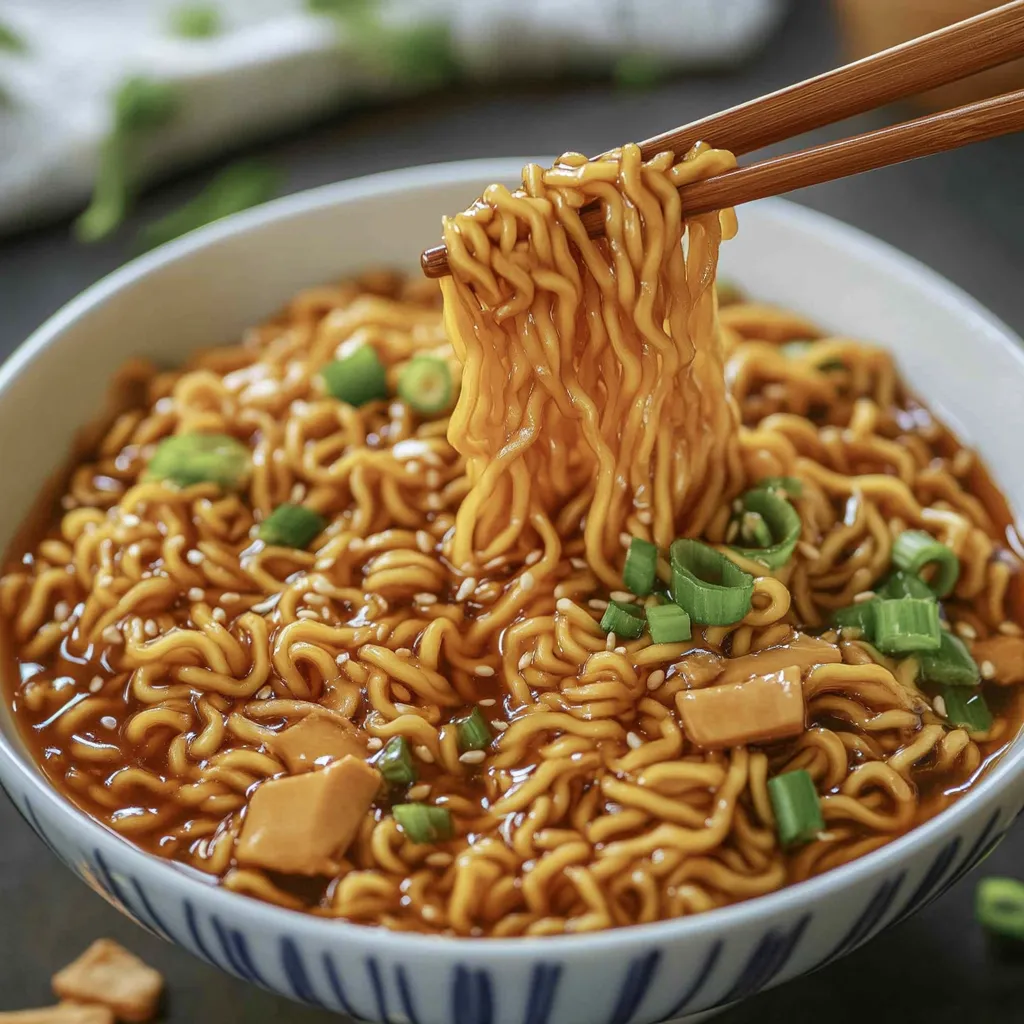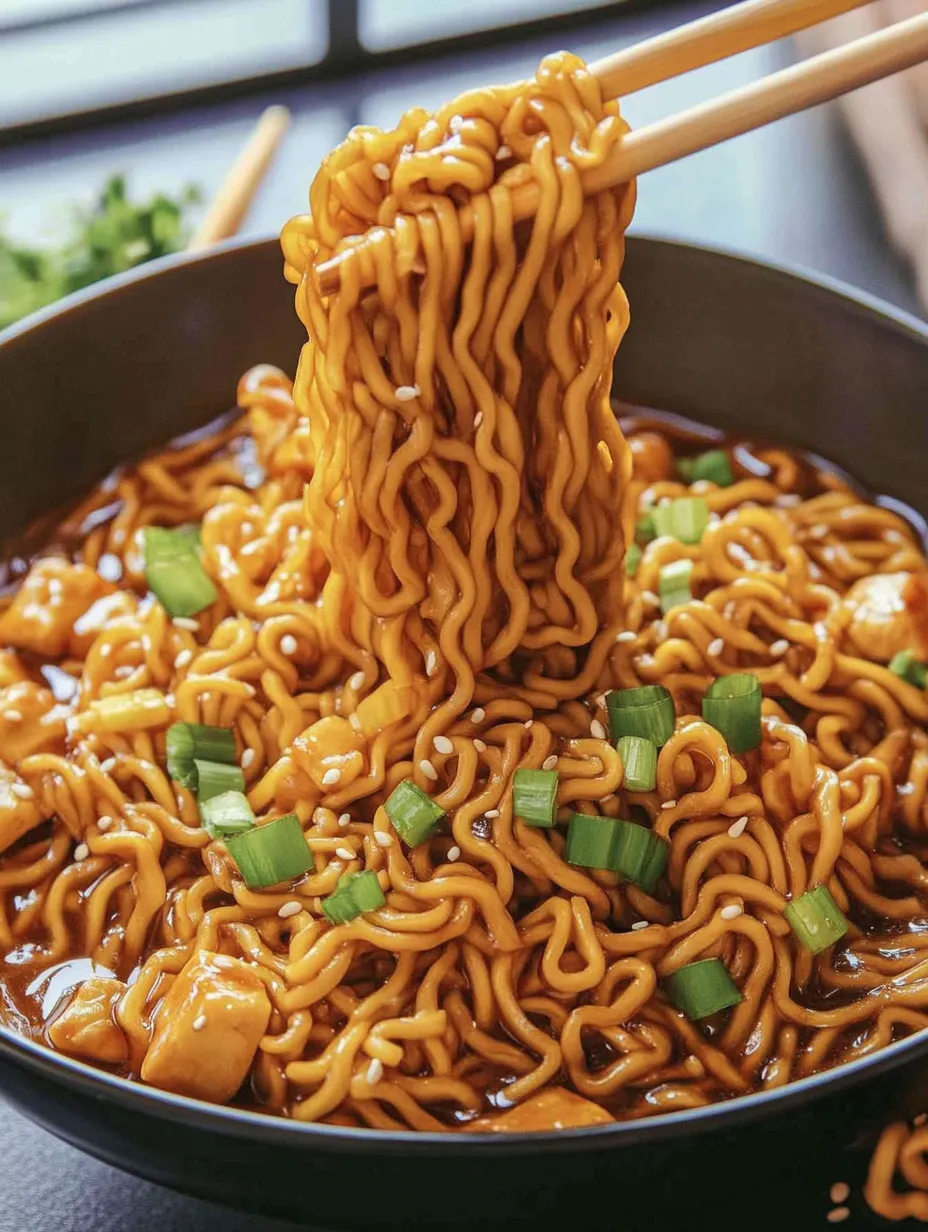 Pin it
Pin it
This hearty saucy ramen noodle dish has become my weeknight savior when I need something quick yet incredibly satisfying. The thick, glossy sauce clings perfectly to the chewy noodles, creating a restaurant-worthy meal right at home with minimal effort.
I first created this recipe during a particularly busy exam week in college when takeout was straining my budget. It quickly became my go-to comfort food, and now my roommates actually request it whenever they need a pick-me-up after a long day.
Ingredients
- Extra firm tofu: provides the perfect protein boost and absorbs all the delicious sauce flavors
- Instant ramen noodles: work perfectly but feel free to upgrade to fresh noodles for even better texture
- Soy sauce: creates that essential umami base look for naturally brewed varieties for best flavor
- Dark soy sauce: adds rich color and deeper flavor to the sauce
- Corn starch: is the secret to that thick restaurant style coating that clings to every noodle
- Rice vinegar: balances the saltiness with subtle acidity
- Chili garlic sauce: adds customizable heat choose your favorite brand or make your own
- Sesame oil: provides that distinctive nutty aroma that makes this dish irresistible
Step-by-Step Instructions
- Prepare the Sauce:
- Mix all sauce ingredients thoroughly in a bowl until well incorporated. This is when you can adjust sweetness, saltiness, and spice levels to your preference. The cornstarch might settle at the bottom, so give it another good stir before using.
- Cook the Noodles:
- Bring water to a rolling boil in a pot. Add your ramen noodles but intentionally undercook them by 2-3 minutes less than package instructions. They should still have a firm bite in the center as they'll finish cooking in the sauce. Drain immediately and optionally rinse with cold water to stop cooking.
- Sauté the Proteins and Vegetables:
- Heat a large pan or wok over medium high heat with a small amount of neutral oil. Add your tofu, vegetables, or mushrooms and cook for 3-4 minutes until they develop some color but still maintain texture. Different vegetables require different cooking times, so add harder vegetables like carrots first.
- Create the Glossy Sauce:
- Pour your prepared sauce mixture into the pan, making sure to scrape all the cornstarch from the bottom of your mixing bowl. Let it simmer for 2-3 minutes, stirring constantly as it begins to thicken and turn glossy. The sauce should coat the back of a spoon but still be pourable.
- Combine and Finish:
- Add your drained, partially cooked noodles to the thickened sauce. Toss continuously over medium high heat for about 3 minutes. The noodles will absorb some sauce and finish cooking while the remaining sauce thickens to the perfect consistency. The finished dish should have glossy, sauce coated noodles without pooling liquid.
 Pin it
Pin it
The tofu in this recipe completely transformed my opinion about this protein. I used to find it bland and boring, but when it absorbs this intensely flavored sauce, it becomes the star of the dish. My partner who typically avoids tofu specifically requests this dish at least once a week now.
Sauce Magic
The secret to this dish's success lies in the carefully balanced sauce. The combination of soy sauce, sweetener, and vinegar creates what Chinese cooking calls a "complex flavor profile" with elements of salty, sweet, and sour all working together. While the recipe provides measurements, I encourage you to taste and adjust as you go. Some days you might prefer it sweeter, other days more savory. The sauce also works wonderfully for stir frying vegetables or as a dipping sauce for dumplings.
Protein Options
While the recipe suggests tofu, this dish welcomes any protein you prefer. For animal proteins, thinly sliced chicken breast or thigh works beautifully when marinated briefly in a tablespoon of soy sauce before cooking. Shrimp needs just a quick sauté until pink. For vegetarians beyond tofu, try cubed tempeh or seitan for different textures. The key with any protein is not to overcook it before adding the sauce, as it will continue to cook when combined with the noodles.
Noodle Knowledge
Though instant ramen noodles are convenient and work perfectly here, this sauce pairs wonderfully with many Asian noodle varieties. Fresh ramen noodles offer better texture if you can find them. Udon provides a delightfully chewy bite. Even rice noodles can work though they absorb sauce differently. Whatever noodle you choose, remember the golden rule of Asian noodle cooking always undercook slightly before adding to your sauce, as they will continue absorbing liquid and cooking in the final step.
Vegetable Variations
The beauty of this recipe is how it embraces whatever vegetables you have on hand. Quick cooking vegetables like thinly sliced bell peppers, snow peas, or bean sprouts can be added directly with the sauce. Heartier vegetables like broccoli, cauliflower, or carrots benefit from a brief blanching before adding to the stir fry. My personal favorite combination includes thinly sliced red bell pepper, baby bok choy, and mushrooms for a variety of textures and colors.
Frequently Asked Questions
- → What type of noodles should I use?
You can use instant ramen noodles or any noodles of your choice, such as soba, udon, or rice noodles.
- → Can I adjust the sweetness of the sauce?
Yes, the sweetness can be adjusted by varying the amount of sugar, maple syrup, or other sweetener you use in the sauce.
- → How do I prevent the noodles from overcooking?
Half-cook the noodles, leaving them chewy, and rinse them with cold water before adding to the sauce to stop further cooking.
- → Can I make this dish spicier?
To make the dish spicier, you can add more chili garlic sauce, hot sauce, or even fresh chili peppers.
- → Is the sauce suitable for other dishes?
Yes, the sauce is versatile and works great for stir-fries or as a dipping sauce for other meals.
